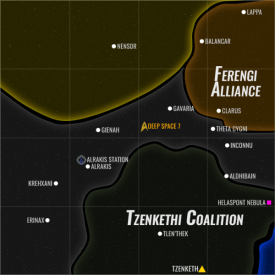Planets
Chentia
A small, flat, muddy planet. There are no oceans, instead much of the surface is covered with a shallow layer of water. A single large moon creates a strong tidal effect, essentially making the entire planet a tidal mudflat. Microscopic plants live in the mud, giving it a brown-green colouration in places. Although most of the planet experiences regular flooding, there are a few places high enough to remain dry.
Khrexani
The second planet closest to the sun, this is the original homeworld of the Khrenal. It's not known when exactly that the Khrenal evolved here. Khrexani is about 2.3 times bigger than Earth.The planet is made up of 5 continents, which make up 46% of the planet's landmass. 4 moons orbit the planet. The bulk of the Ravager military installations are on these 4 moons, including their ship building facilities. Being a scavenger race these facilities often have hundreds of kilometers of storage space, containing all the raw materials that they find, to build their ships from.
The plant-like organisms on this planet are almost exclusively made up of bushes. While flowers and trees exist, there are hardly any food bearing plants on the planet, those having become extinct through centuries of use as a primary food source. Sentient life is abundant on this planet. Birds, reptiles, mammals and even fish. Very few of them have any sort of intelligence, however the Khrelan evolved from one of the intelligent mammal like species, eventually rising to the top of the food chain.
Amasis
Amasis is a gas giant, and the third planet in the Khrexani system. This large gas giant has an atmosphere mostly composed of hydrogen. There are two giant storm systems in the planet's atmosphere (similar to the Great Red Spot of Jupiter). The planet is orbited by a swarm of derelict spaceships, including many decommissioned military vessels. A space station watches over this orbital junkyard and sells salvaged parts at a fair price to either various Ravager factions, or anyone looking to buy. This station, Amasis Trade Port, is often the first port of call for a majority of people venturing into the system, due its sheer size, it is often confused for the main station of the Ravagers, which is actually in orbit around Khrexani.
Pertinas
A tropical world known for its rainforests, Pertinas is a single continent that stretches unbroken around the planet's equator, separating the northern and southern oceans. These rainforests are made up of trees that thrive in low oxygen environments, which allows them to produce huge amounts of CO2. This continent is teeming with life, as are the oceans. But while this planet is a paradise for its native life-forms, a lack of oxygen and high levels of CO2 make it uninhabitable to Ravagers.
Khriasi
A lush jungle planet slightly larger than Earth. The planet rotates very slowly on its axis, causing long hot days and cold nights. A relatively small axial tilt makes for a stable, predictable climate. While the planet's landmasses are heavily forested, there also exist several open grassland regions; one such region has been settled by Ravagers. Much of the plain has been given over to farmland, and a central city is now home to several thousand Ravagers, from all the castes. The planet is on its way to becoming important, agricultural colony. There is an Erganite base in the southern hemisphere, where a large amount of training is undertaken.
Segama
The planet Segama, named so for the crystal Segamite, is a desert planet. There are 2 moons, both containing Azulren research stations.
The plant-like organisms on this planet are mostly bushes, shrubs and flowers, with a good amount of fungi and grasses but very few tree species. The shrubs are the dominant organism on this planet as they grow fast and wide, with many different shapes, sizes and colors.
While most organisms don't have to fear being completely destroyed when eaten by animals, some have made sure they will survive either way. Some will prevent being eaten by tasting horrible, by growing thorns or by being poisonous. But there are a handful of species who, in a way, need to be eaten. When an animal begin eaten these species, they will release the seeds around the eaten area, which are either swept away with the wind or get stuck on the animal to be taken away and thus ensure the species can continue to grow in other areas.
When first discovered by the Azulren, they discovered caves along the equator, containing beautiful orange crystals. The scientific nature of the Azulren was intrigued by this. They studied the crystals and discovered that they could be used much like dilithium crystals, though with a much quicker breakdown rate, requiring they be replaced more often.
Azuphria
The furthest planet from the sun, this is the homeworld of the Azulren. The Azulren evolved from a form of primate mammal on this planet. The plant-like organisms on this planet are almost all huge, towering trees, high above a layer of various shrubs, grasses and flowers. The trees can and often will completely block out light, which sometimes leads to a fairly empty ground layer, full of dead leaves.
If it weren't for the few dozen aquatic plants, the waters of this planet would be nearly lifeless. However, the few plant species that do exist have conquered every part covered in water. Many of them are highly specialized in surviving a specific depth, which gives every depth its own unique eco-system and all the beauty that comes with it.
This planet is home to many sentient creatures. The Azulren, and several bird, reptile and amphibian kingdoms have the most sentient species, but the mammals and fish have their fair share as well. When first evolving, the Azulren began in as small communities in town-like constructions. They make up the scientific or technological caste of the Ravagers, and what they lack in physical strength, the make up for in intelligence.

